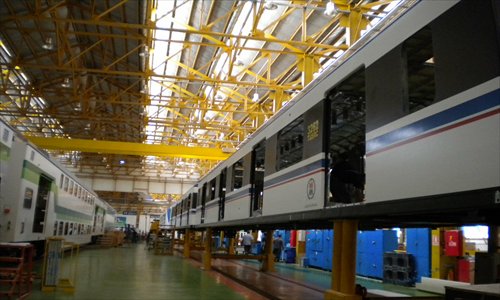Turning sanctions into opportunity

It's early on a weekday afternoon, and Sadeghieh station in downtown Tehran is bustling with passengers. Thanks to Chinese investment, a train painted in bright white, green and blue prepares for departure, helping people to move ahead in an economy crippled by sanctions and diplomatic isolation.
Iran is in dire need of investment and business know-how, and its huge economic potential makes it a tempting destination for foreign companies. Strained relations between Iran and the West have created business opportunities for Chinese companies.
Currently, more than 60 large-scale Chinese enterprises have a presence in Iran, mainly focusing on the energy, rail transportation, resources, telecommunication, automobile and power-generation sectors. In 2011, the bilateral trade volume between China and Iran reached $45.1 billion, according to China's Ministry of Foreign Affairs.
But these business opportunities come with extremely high stakes. Sanctions and Iran's geopolitical situation make doing business there extremely risky. As the country's financial infrastructure has been cut off from global institutions, making a simple payment is a big challenge for any company doing trans-border business in Iran.
"It's very difficult, but we don't want to give up on this market," said a veteran Chinese businessman based in Tehran. "It is a unique market where literally every industry has huge demand."
Jointly building the future
The double-decker train of subway Line 5 at Sadeghieh station, designed by Chinese company Norinco International, links Tehran and Karaj, a satellite city of two million people. Around 400,000 people commute daily along the 43-kilometer line. The train was manufactured by Tehran Wagon Manufacturing Co (TWM), a joint venture between Norinco and the Tehran subway operator.
TWM is located in the southwest of Tehran. In the huge sheltered workshop, staff carry out a variety of jobs from electrical wiring to cabin water-proofing. In one corner, a white board displays different shifts.
In many ways, TWM appears to be a modern manufacturing site. In its seven years, TWM has mastered the advanced technology required for building subway trains.
The joint venture is now pressing ahead with subway systems in other Iranian cities. Factories like this would hardly raise an eyebrow in developed or emerging countries, but this one carries a special significance in Tehran. It represents the ambition of a Muslim country seeking to revive itself in the face of decades of sanctions and isolation. The factory also represents Chinese enterprises' twisting road of expansion in Iran.
Detour from development
Halfway along Line 5, an expansive Asian Games complex can be seen. Tehran hosted the Asian Games in 1974 in a huge show of national strength before the 1979 revolution. The games were meant to showcase Iran's regional status and level of modernization. The regime of that time had the ambition of turning Iran into the "Japan of west Asia."
Today, dilapidated buildings against the backdrop of barren mountains reflect only a sense of bitterness. Iran's modernization drive was disrupted by its eight-year war with Iraq and rounds of tough sanctions imposed by the West. According to World Bank data, Iran's GDP ranked 32nd in the world in 2011, behind Thailand and Colombia.
Iran, still a formidable force in west Asia and one of the world's major oil exporters, is seeking opportunities out of oppressive conditions. Modern factories do more than fill a market void and see off competitors. "We can use the sanctions to develop Iran," said Hossein Kanani Moghaddam, founder and general secretary of the Green Party. "If we can't purchase some goods from the US, we can produce from Iran. It can help Iranian people, and use the power to go against the sanctions."
Although it sits on rich oil reserves, Iran has tried to avoid the "oil curse" by developing a diverse industrial system and pursuing independent diplomacy. At the moment, the economic data is still worrying. Inflation, high unemployment and a growing income gap continue to overshadow the country. At the same time, the government has to strike a balance between fostering effective competition in the market and taking care of its poor.
Winning together
Indeed, signs of hope can be seen in Tehran. A desire to change has made parts of the city veritably bustling. In the northern part of the capital, luxurious office towers are being built. In the west, a hemispherical high-end shopping mall is under construction. In the downtown shopping district, fashionable items, from the latest electronic gadgets to trendy jeans, are a ubiquitous sight. Chinese companies are seeking opportunities to prosper.
Subway Line 5 is expected to expand further west, given its smooth operation and Tehran's rising demand for transportation. Smaller towns along the route have been integrated into the broader economic belt, creating more jobs outside the super-sized capital. This subway line also defies the widely-held stereotype that China's investment in Iran solely targets the energy sector. This is a typical win-win project that benefits locals and increases Chinese companies' market share.
As rush hour approaches, the train and platform become more crowded, and thousands of people end their work for the day as they seek to fulfill their ambitions and desires.